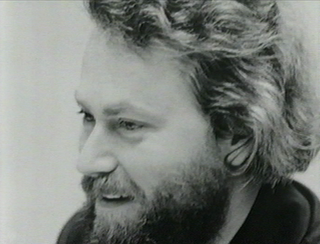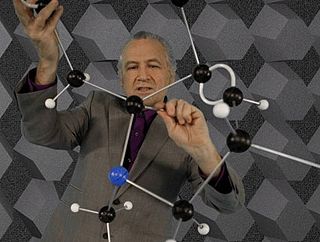
Dan Flavin was an American minimalist artist famous for creating sculptural objects and installations from commercially available fluorescent light fixtures.

Donald Clarence Judd was an American artist associated with minimalism. In his work, Judd sought autonomy and clarity for the constructed object and the space created by it, ultimately achieving a rigorously democratic presentation without compositional hierarchy. He is generally considered the leading international exponent of "minimalism", and its most important theoretician through such writings as "Specific Objects" (1964). Judd voiced his unorthodox perception of minimalism in Arts Yearbook 8, where he says, "The new three dimensional work doesn't constitute a movement, school, or style. The common aspects are too general and too little common to define a movement. The differences are greater than the similarities."

Robert Walter Irwin was an American installation artist who explored perception and the conditional in art, often through site-specific, architectural interventions that alter the physical, sensory and temporal experience of space.

Jay DeFeo was a visual artist who became celebrated in the 1950s as part of the spirited community of Beat artists, musicians, and poets in San Francisco. Best known for her monumental work The Rose, DeFeo produced courageously experimental works throughout her career, exhibiting what art critic Kenneth Baker called “fearlessness.”

Michael Heizer is an American land artist specializing in large-scale and site-specific sculptures. Working largely outside the confines of the traditional art spaces of galleries and museums, Heizer has redefined sculpture in terms of size, mass, gesture, and process. A pioneer of 20th-century land art or Earthworks movement, he is widely recognized for sculptures and environmental structures made with earth-moving equipment, which he began creating in the American West in 1967. He currently lives and works in Hiko, Nevada, and New York City.

Gary Hill is an American artist who lives and works in Seattle, Washington. Often viewed as one of the foundational artists in video art, based on the single-channel work and video- and sound-based installations of the 1970s and 1980s, he in fact began working in metal sculpture in the late 1960s. Today he is best known for internationally exhibited installations and performance art, concerned as much with innovative language as with technology, and for continuing work in a broad range of media. His longtime work with intermedia explores an array of issues ranging from the physicality of language, synesthesia and perceptual conundrums to ontological space and viewer interactivity. The recipient of many awards, his influential work has been exhibited in most major contemporary art museums worldwide.

Lawrence Charles Weiner was an American conceptual artist. He was one of the central figures in the formation of conceptual art in the 1960s. His work often took the form of typographic texts, a form of word art.

John Rivers Coplans was a British artist, art writer, curator, and museum director. A veteran of World War II and a photographer, he emigrated to the United States in 1960 and had many exhibitions in Europe and North America. He was on the founding editorial staff of Artforum from 1962 to 1971, and was Editor-in-Chief from 1972 to 1977.
Jim Hodges is a New York-based installation artist. He is known for his mixed-media sculptures and collages that involve delicate artificial flowers, mirrors, chains as spiderwebs, and cut-up jeans.
Imi Knoebel is a German artist. Knoebel is known for his minimalist, abstract painting and sculpture. The "Messerschnitt" or "knife cuts," is a recurring technique he employs, along with his regular use of the primary colors, red, yellow and blue. Knoebel lives and works in Düsseldorf.
José Toirac is a Cuban artist specializing in painting, drawing, and installation.
Michelle Stuart is an American multidisciplinary artist known for her sculpture, painting and environmental art. She is based in New York City.

Dan Owen Dailey is an American artist and educator, known for his sculpture. With the support of a team of artists and crafts people, he creates sculptures and functional objects in glass and metal. He has taught at many glass programs and is professor emeritus at the Massachusetts College of Art, where he founded the glass program.
Gary Schneider is a South African-born American photographer known for his portraiture and self-portraits. According to the John Simon Guggenheim Memorial Foundation, which awarded him a Guggenheim Fellowship in 2013, his "early work in painting, performance, and film remain integral to his explorations of portraiture. He strives to marry art and science, identity and obscurity, figuration and abstraction, the carnal and the spiritual."
Robert Hite (1956–2020) was an American visual artist. Hite was born in Richmond, Virginia, and lived and worked in Esopus, New York. Robert Hite was inspired both by a rich Southern narrative tradition and closeness to nature. The imagery in his work draws upon the memories of his childhood in rural Virginia during the Civil Rights Movement era. Hite's work explored issues of local knowledge, memory, transience, environment, disenfranchisement and domicile as living art. Much of his photographic work juxtaposes the artificial and the natural and play with architectural scale. In April 2014, Hite was named as a Guggenheim Fellow for his work in fine arts.
Harold Jacob Bruder is an American realist painter. In 1984, he was honored with a National Endowment for the Arts Fellowship. He is a former professor of art, working with the Kansas City Art Institute, Pratt Institute, National Academy of Design, Aspen Art Museum, and Queens College of the City University of New York (CUNY). He served as the Chairman of the Art Department at CUNY, where he taught painting and drawing for 30 years, retiring in 1995, as Professor Emeritus.
Eusebio Sempere Juan was a Spanish sculptor, painter, and graphic artist whose abstract geometric works make him the most representative artist of the Kinetic art movement in Spain and one of Spain's foremost artists. His use of repetition of line and mastery of color to manipulate the way light plays on the surface give depth to his pictorial compositions.
Leslie Thornton is an American avant-garde filmmaker and artist.
William E. F. Heeks, Jr., popularly known as Willy Heeks, is an American abstract expressionist painter.

Richard Whitten is a painter and sculptor of mixed Asian and American ancestry working in Rhode Island. His early work could loosely be termed geometric abstractions, but he is best known for his later representational paintings that combine an interest in architecture, invented machinery and toys. Whitten is also known for his toy-like sculptures. Whitten was the chair of the art department at Rhode Island College (2016-2018) and continues to teach there as part of the faculty.









